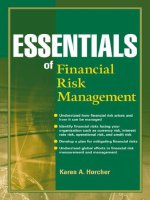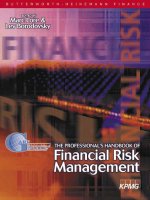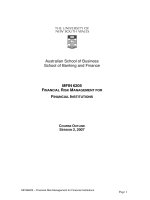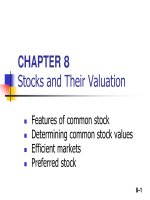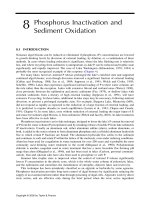Elements of financial risk management chapter 8
Bạn đang xem bản rút gọn của tài liệu. Xem và tải ngay bản đầy đủ của tài liệu tại đây (724.13 KB, 50 trang )
1
Simulating the
Term Structure of Risk
Elements of
Financial Risk Management
Chapter 8
Peter Christoffersen
Elements of Financial Risk Management Second Edition © 2012 by Peter Christoffersen
Overview
2
• When the horizon of interest is longer than one day, we
need to rely on simulation methods for computing VaR and
ES to compute entire term structure of risk
• First, we will consider simulating forward the univariate
risk models by using Monte Carlo simulation and Filtered
Historical Simulation
• Second, we simulate forward in time multivariate risk
models with constant correlations across assets using
Monte Carlo as well as FHS
• Third, we simulate multivariate risk models with dynamic
correlations using the DCC model
Elements of Financial Risk Management Second Edition © 2012 by Peter Christoffersen
The Risk Term Structure in Univariate
Models
3
• When portfolio returns are normally distributed with a constant
variance, σ2PF, returns over the next K days are also normally
distributed, but with variance K σ2PF
• The VaR for returns over the next K days calculated on day t is
• and similarly ES can be computed as
Elements of Financial Risk Management Second Edition © 2012 by Peter Christoffersen
The Risk Term Structure in
Univariate Models
• The variance of the K-day return is in general:
• where we have omitted the portfolio, PF, subscripts
• In the simple RiskMetrics variance model, where
, we get
• so that variances actually do scale by K in the RiskMetrics model
Elements of Financial Risk Management Second Edition © 2012 by Peter Christoffersen
4
The Risk Term Structure in
Univariate Models
5
• In the symmetric GARCH(1,1) model, where
, we get
• where
• is the unconditional, or average, long-run variance
• In GARCH, the variance does mean revert and it does not
scale by the horizon K, and the returns over the next K days
are not normally distributed
• In GARCH, as K gets large, the return distribution does
approach the normal distribution
Elements of Financial Risk Management Second Edition © 2012 by Peter Christoffersen
The Risk Term Structure in Univariate
Models
6
• In Chapter 1 we discussed average daily return: First, that it
is very difficult to forecast, and, second that it is very small
relative to daily standard deviation
• At a longer horizon, it is difficult to forecast the mean but its
relative importance increases with horizon
• Consider an example where daily returns are normally
distributed with a constant mean and variance as in
• The 1-day VaR is thus
Elements of Financial Risk Management Second Edition © 2012 by Peter Christoffersen
The Risk Term Structure in Univariate
Models
7
• The K-day return in this case is distributed as
• and the K-day VaR is thus
• As the horizon, K, gets large, the relative importance of the
mean increases
• Similarly, for ES
Elements of Financial Risk Management Second Edition © 2012 by Peter Christoffersen
Monte Carlo Simulation
8
• Consider our GARCH(1,1)-normal model of returns
• and
• In the GARCH model, at the end of day t we obtain Rt and
we can calculate σ2t+1 ,tomorrow’s variance
• Using random number generators, we can generate a set of
artificial (or pseudo) random numbers drawn from the
standard normal distribution, N(0,1)
• MC denotes the number of draws around 10,000
Elements of Financial Risk Management Second Edition © 2012 by Peter Christoffersen
Monte Carlo Simulation
9
• QQ plot of the random numbers is constructed to confirm
that the random numbers conform to the standard normal
distribution
• From these random numbers we can calculate a set of
hypothetical returns for tomorrow as
• Given these hypothetical returns, we can update the
variance to get a set of hypothetical variances for the day
after tomorrow, t+2, as follows:
• Given a new set of random numbers drawn from the N(0,1)
distribution
Elements of Financial Risk Management Second Edition © 2012 by Peter Christoffersen
Monte Carlo Simulation
• we can calculate hypothetical return on day t+2 as
• and the variance is now updated using
• Graphically, we can illustrate the simulation of
hypothetical daily returns from day t+1 to day t+K as
Elements of Financial Risk Management Second Edition © 2012 by Peter Christoffersen
10
Monte Carlo Simulation
• Each row corresponds to a Monte Carlo simulation path,
which branches out from σ2t+1 on the first day, but which
does not branch out after that
• On each day a given branch gets updated with a new
random number, which is different from the one used any
of the days before
• We end up with MC sequences of hypothetical daily
returns for day t+1 through day t+K
Elements of Financial Risk Management Second Edition © 2012 by Peter Christoffersen
11
Monte Carlo Simulation
12
• From these hypothetical future daily returns, we can easily
calculate the hypothetical K-day return from each Monte
Carlo path as
• Collect these MC hypothetical K-day returns in a set
.
and calculate the K-day value at
risk by calculating the 100pth percentile as in
• ES at different horizons using Monte Carlo
Elements of Financial Risk Management Second Edition © 2012 by Peter Christoffersen
Monte Carlo Simulation
13
• where 1(*) takes the value 1 if the argument is true and zero
otherwise
• GARCH-MCS method builds on today’s estimate of
tomorrow’s variance
• MCS can be used for any assumed distribution of
standardized returns—normality is not required
• MCS technique can also be used for any fully specified
dynamic variance model
Elements of Financial Risk Management Second Edition © 2012 by Peter Christoffersen
Figure 8.1: VaR Term Structures using NGARCH
and Monte Carlo Simulation
Notes to Figure: The left panel shows the S&P 500 VaR per day
across horizons when the current volatility is one half its long run
value. The right panel assumes the current volatility is 3 times its
long run value.
Elements of Financial Risk Management Second Edition © 2012 by Peter Christoffersen
14
Monte Carlo Simulation
15
• In Figure 8.1, the VaR is simulated using Monte Carlo on
an NGARCH model
• We use MCS to construct VaR per day as a function of
horizon K for two different values of σt+1
• In the left panel the initial volatility is one-half the
unconditional level and in the right panel σt+1 is three
times the unconditional level.
• The horizon goes from 1 to 500 trading days
• The VaR coverage level p is set to 1%
Elements of Financial Risk Management Second Edition © 2012 by Peter Christoffersen
Monte Carlo Simulation
16
• Figure 8.1 shows that the term structure of VaR is initially
upward sloping both when volatility is low and when it is
high
• The VaR term structure is also driven by the term structure
of skewness and kurtosis and other moments
• Kurtosis is strongly increasing at short horizons and then
decreasing for longer horizons
• This hump-shape in the term structure of kurtosis creates
the hump in the VaR as seen in the right panel of Figure
8.1 when the initial volatility is high
Elements of Financial Risk Management Second Edition © 2012 by Peter Christoffersen
Figure 8.2: ES Term Structures using NGARCH and
Monte Carlo Simulation
Notes to Figure: The left panel shows the S&P 500 ES per day
across horizons when the current volatility is one half its long run
value. The right panel assumes the current volatility is 3 times its
long run value.
Elements of Financial Risk Management Second Edition © 2012 by Peter Christoffersen
17
Monte Carlo Simulation
18
• In Figure 8.2, the ES is simulated using Monte Carlo on an
NGARCH model
• Here we plot the ESPt+1:t+K per day, against horizon K
• The coverage level p is again set to 1% and the horizon
goes from 1 to 500 trading days
• Note that the slope of the ES term structure in the left panel
of Figure 8.2 is steeper than the corresponding VaR term
structure in the left panel of Figure 8.1
• The hump in the ES term structure in the right panel of
Figure 8.2 is more pronounced than the hump in the VaR
term structure in the right panel of Figure 8.1
Elements of Financial Risk Management Second Edition © 2012 by Peter Christoffersen
Filtered Historical Simulation (FHS)
• FHS combines model-based methods of variance with
model-free methods of the distribution of shocks
• Here we use the past returns data to tell us about the
distribution without making any assumptions about the
specific distribution
• Consider a GARCH(1,1) model
• where
Elements of Financial Risk Management Second Edition © 2012 by Peter Christoffersen
19
Filtered Historical Simulation (FHS)
20
• Given a sequence of past returns,
, we can
estimate the GARCH model and calculate past
standardized returns from the observed returns and from
the estimated standard deviations as
• The number of historical observations, m, should be as large
as possible
• In GARCH model, at the end of day t we obtain Rt and we
can calculate σ2t+1, which is day t+1’s variance
• We draw random with replacement from our own
database of past standardized residuals,
Elements of Financial Risk Management Second Edition © 2012 by Peter Christoffersen
Filtered Historical Simulation (FHS)
21
• The random drawing can be operationalized by generating
a discrete uniform random variable distributed from 1 to m.
• Each draw from the discrete distribution then tells us which
τ and thus which
to pick from the set
• The distribution of hypothetical future returns:
Elements of Financial Risk Management Second Edition © 2012 by Peter Christoffersen
Filtered Historical Simulation (FHS)
22
• where FH is the number of times we draw from the
standardized residuals on each future date (ex:10000)
• K is horizon of interest measured in number of days
• We end up with FH sequences of hypothetical daily returns
for day t+1 through day t+K.
• From these hypothetical daily returns, we calculate the
hypothetical K-day returns as
Elements of Financial Risk Management Second Edition © 2012 by Peter Christoffersen
Filtered Historical Simulation (FHS)
23
• If we collect the FH hypothetical K-day returns in a set
.
, then we can calculate the K-day
Value-at-Risk by calculating the 100pth percentile as
• The ES can be calculated from the simulated returns by
taking the average of all the
that fall below
the –VaRPt+1:t+k number
• Where indicator function 1(*) returns a 1 if the argument
is true
and zero if not
Elements of Financial Risk Management Second Edition © 2012 by Peter Christoffersen
Filtered Historical Simulation (FHS)
24
• FHS can generate large losses in the forecast period, even
without having observed a large loss in the recorded past
returns
• Consider the case where we have a relatively large
negative z in our database, which occurred on a relatively
low variance day
• If this z gets combined with a high variance day in the
simulation period then the resulting hypothetical loss will
be large
Elements of Financial Risk Management Second Edition © 2012 by Peter Christoffersen
Filtered Historical Simulation (FHS)
• In Figure 8.3, the VaR is simulated using FHS on an
NGARCH model
• The VaR per day is plotted as a function of horizon K for
two different values of σt+1
• In the top panel the initial volatility is one-half the
unconditional level and in the bottom panel σt+1 is three
times the unconditional level.
• The horizons goes from 1 to 500 trading days
• The VaR coverage level p is set to 1% again
Elements of Financial Risk Management Second Edition © 2012 by Peter Christoffersen
25

